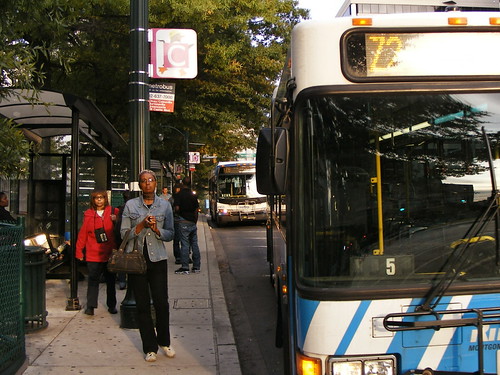
The full list of cuts (PDF!) include five Ride On routes in East County which would be cut completely. Four routes would stop running on weekends, including two Metrobus lines operated by Ride On, the L8 (Connecticut Avenue Line) and Z2 (Colesville-Ashton Line). Two routes, the 7 (Wheaton-Kensington) and 22 (Silver Spring-Hillandale) would lose some weekday service. Routes 15 & 17 (Silver Spring-Langley Park) and 34 (Aspen Hill-Friendship Heights) would run less often in the evenings.
At Rebuilding Place in the Urban Space, planning consultant Richard Layman points out that the $2 million saved by reducing Ride On service could be made up by increasing fares by ten cents. It's easy to say that this would be unfair to working people - after all, that's exactly what they say about tolls on the InterCounty Connector. But if you don't want to pay to drive on the ICC, you can take another road. Transit users who don't or can't drive have no other alternative.
Going to the West Coast revealed to me just how cheap bus fares are in this area. Like Metrobus, Ride-On costs $1.35 to ride, or $1.25 with a SmarTrip card. In San Francisco and Portland, it's $2.00. In Seattle, a variable fare structure means you could pay up to $2.75 to ride the bus at rush hour. Like most public transit systems, none of these cities' buses pay for themselves, but they make it clear that people willingly accept higher fares. If a small increase in bus fares means keeping the service we've got, then by all means it should be implemented.

On the other hand, why should we continue paying for routes with anemically low ridership? The five routes being eliminated are either redundant or serve areas where there are few people. Route 3 (Silver Spring-Takoma) loops around Downtown Silver Spring, blocks from any major attractions. Not surprisingly, it carries just eight people each hour.
Route 33 (Glenmont-Bethesda) avoids major roads like University and Connecticut in favor of a slow, winding trip down neighborhood streets. Route 21 (Silver Spring-Briggs Chaney) was created in 2006 to make up for Metrobus routes that were either cut or changed, but the indirect route that resulted attracts few riders.
Route 31 (Wheaton-Glenmont) wraps around Wheaton Regional Park. Route 53 (Shady Grove-Glenmont) ambles through parks and farmland outside of Olney. Kathy Jentz, editor of Washington Gardener magazine, has written about the importance of bringing transit to nature, but farms and parks aren't good at drumming up riders.
Rather than saving $2 million by cutting underperforming lines, we should redirect the money toward creating more efficient service. And if that's not enough to put buses in places where people can and will use them, we should increase bus fares as well. Paying more to ride the bus can be a financial hardship - but if people can't get to work, how do we expect them to cough up any money at all?

5 comments:
In these economic times, I'd argue we need NEITHER higher fares NOR any service cuts. What we do need is a smarter redistribution of our transit budget that comes from all over our taxes.
One thing worth mentioning is that buses are free in downtown Seattle during the day.
They are, but the fareless area is pretty small. You might argue that those free fares make the rest of the system more expensive, but I don't know.
People in Haiti are dying by the thousands and you're politicking for higher bus-fares in Montgomery.
Wow. Way to show you care. Clearly higher bus-fares aren't going to make people use their cars less... especially when routes are cut and there's no alternative.
How many bus routes are running in Haiti, Dan?
Why not write about them?
Ridership on the Ride-On system would increase (thereby generate more money) if a) the routes were better advertised to get people out of their cars and b) if they arrived at bus stops within 5minutes of their scheduled time.
Post a Comment